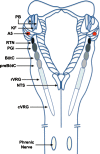The emerging role of AMPK in the regulation of breathing and oxygen supply
- PMID: 27574022
- PMCID: PMC5003690
- DOI: 10.1042/BCJ20160002
The emerging role of AMPK in the regulation of breathing and oxygen supply
Abstract
Regulation of breathing is critical to our capacity to accommodate deficits in oxygen availability and demand during, for example, sleep and ascent to altitude. It is generally accepted that a fall in arterial oxygen increases afferent discharge from the carotid bodies to the brainstem and thus delivers increased ventilatory drive, which restores oxygen supply and protects against hypoventilation and apnoea. However, the precise molecular mechanisms involved remain unclear. We recently identified as critical to this process the AMP-activated protein kinase (AMPK), which is key to the cell-autonomous regulation of metabolic homoeostasis. This observation is significant for many reasons, not least because recent studies suggest that the gene for the AMPK-α1 catalytic subunit has been subjected to natural selection in high-altitude populations. It would appear, therefore, that evolutionary pressures have led to AMPK being utilized to regulate oxygen delivery and thus energy supply to the body in the short, medium and longer term. Contrary to current consensus, however, our findings suggest that AMPK regulates ventilation at the level of the caudal brainstem, even when afferent input responses from the carotid body are normal. We therefore hypothesize that AMPK integrates local hypoxic stress at defined loci within the brainstem respiratory network with an index of peripheral hypoxic status, namely afferent chemosensory inputs. Allied to this, AMPK is critical to the control of hypoxic pulmonary vasoconstriction and thus ventilation-perfusion matching at the lungs and may also determine oxygen supply to the foetus by, for example, modulating utero-placental blood flow.
Keywords: AMP-activated protein kinase (AMPK); Ca2+–calmodulin-activated kinase kinase-β (CaMKK-β); apnoea; hypoxia; liver kinase B1 (LKB1); pulmonary; ventilation.
© 2016 The Author(s).
Figures




Comment in
-
A paradigm shift in oxygen sensing with a twist in the tale!Biochem J. 2016 Sep 1;473(17):2687-9. doi: 10.1042/BCJ20160500. Biochem J. 2016. PMID: 27574024
Similar articles
-
SubSol-HIe is an AMPK-dependent hypoxia-responsive subnucleus of the nucleus tractus solitarius that coordinates the hypoxic ventilatory response and protects against apnoea in mice.Pflugers Arch. 2024 Jul;476(7):1087-1107. doi: 10.1007/s00424-024-02957-6. Epub 2024 Apr 18. Pflugers Arch. 2024. PMID: 38635058 Free PMC article.
-
AMPK breathing and oxygen supply.Respir Physiol Neurobiol. 2019 Jul;265:112-120. doi: 10.1016/j.resp.2018.08.011. Epub 2018 Sep 19. Respir Physiol Neurobiol. 2019. PMID: 30243821 Review.
-
AMP-activated Protein Kinase Deficiency Blocks the Hypoxic Ventilatory Response and Thus Precipitates Hypoventilation and Apnea.Am J Respir Crit Care Med. 2016 May 1;193(9):1032-43. doi: 10.1164/rccm.201508-1667OC. Am J Respir Crit Care Med. 2016. PMID: 26669206 Free PMC article.
-
LKB1 is the gatekeeper of carotid body chemosensing and the hypoxic ventilatory response.Commun Biol. 2022 Jun 29;5(1):642. doi: 10.1038/s42003-022-03583-7. Commun Biol. 2022. PMID: 35768580 Free PMC article.
-
AMPK and the Need to Breathe and Feed: What's the Matter with Oxygen?Int J Mol Sci. 2020 May 15;21(10):3518. doi: 10.3390/ijms21103518. Int J Mol Sci. 2020. PMID: 32429235 Free PMC article. Review.
Cited by
-
Gene panel diagnostics reveals new pathogenic variants in pulmonary arterial hypertension.Respir Res. 2022 Mar 27;23(1):74. doi: 10.1186/s12931-022-01987-x. Respir Res. 2022. PMID: 35346192 Free PMC article.
-
Flaxseed Polysaccharide Alters Colonic Gene Expression of Lipid Metabolism and Energy Metabolism in Obese Rats.Foods. 2022 Jul 5;11(13):1991. doi: 10.3390/foods11131991. Foods. 2022. PMID: 35804806 Free PMC article.
-
Metformin accelerates myelin recovery and ameliorates behavioral deficits in the animal model of multiple sclerosis via adjustment of AMPK/Nrf2/mTOR signaling and maintenance of endogenous oligodendrogenesis during brain self-repairing period.Pharmacol Rep. 2020 Jun;72(3):641-658. doi: 10.1007/s43440-019-00019-8. Epub 2019 Dec 18. Pharmacol Rep. 2020. PMID: 32048246
-
SubSol-HIe is an AMPK-dependent hypoxia-responsive subnucleus of the nucleus tractus solitarius that coordinates the hypoxic ventilatory response and protects against apnoea in mice.Pflugers Arch. 2024 Jul;476(7):1087-1107. doi: 10.1007/s00424-024-02957-6. Epub 2024 Apr 18. Pflugers Arch. 2024. PMID: 38635058 Free PMC article.
-
Acute oxygen sensing by the carotid body: a rattlebag of molecular mechanisms.J Physiol. 2018 Aug;596(15):2969-2976. doi: 10.1113/JP274351. Epub 2017 Dec 27. J Physiol. 2018. PMID: 29214644 Free PMC article. Review.
References
-
- Bigham A.W., Julian C.G., Wilson M.J., Vargas E., Browne V.A., Shriver M.D., Moore L.G. Maternal PRKAA1 and EDNRA genotypes are associated with birth weight, and PRKAA1 with uterine artery diameter and metabolic homeostasis at high altitude. Physiol. Genomics. 2014;46:687–697. doi: 10.1152/physiolgenomics.00063.2014. - DOI - PMC - PubMed
-
- Mahmoud A.D., Lewis S., Juricic L., Udoh U.A., Hartmann S., Jansen M.A., Ogunbayo O.A., Puggioni P., Holmes A.P., Kumar P., et al. AMP-activated protein kinase deficiency blocks the hypoxic ventilatory response and thus precipitates hypoventilation and apnea. Am. J. Respir. Crit. Care Med. 2016;193:1032–1043. doi: 10.1164/rccm.201508-1667OC. - DOI - PMC - PubMed
Publication types
MeSH terms
Substances
Grants and funding
LinkOut - more resources
Full Text Sources
Other Literature Sources
Molecular Biology Databases
Miscellaneous

